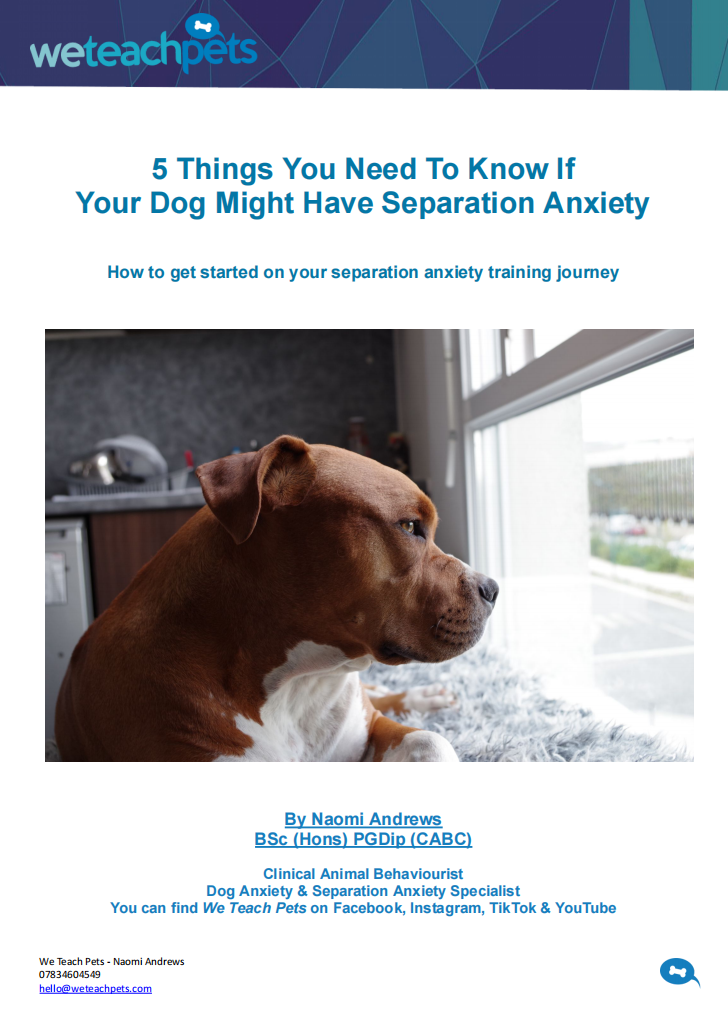Don’t fall for common separation anxiety myths
Whether it’s dog behaviour issues, child raising or house repairs, as soon as you mention you have a problem, everyone becomes an expert! There are many separation anxiety myths circulating which might get in the way of your training.
I’m sure we’ve all had it where we mention in passing to another dog owner in the park, or the hairdresser, that our dog is doing ‘x’ behaviour and they have all sorts of ideas of what you should do. It is well meaning, and some people really do have some great solutions. But it’s important to not get so swept up in trying all these ideas until you know what advice to treat with suspicion. Some advice will be harmless but not useful. Some advice could make things worse, or at least delay you getting the right steps in place.
Read on for some of the most common that I’ve heard:
1. Get another dog for company – top of the separation anxiety myths!
 This is a really common piece of advice. And I totally get the logic. If your dog doesn’t like being alone, then leave him with a buddy and he won’t be alone. Problem solved, right? This is sometimes the case. But more often than not it makes no difference. This is because dogs with separation anxiety very often need people company, or even the company of specific people.
This is a really common piece of advice. And I totally get the logic. If your dog doesn’t like being alone, then leave him with a buddy and he won’t be alone. Problem solved, right? This is sometimes the case. But more often than not it makes no difference. This is because dogs with separation anxiety very often need people company, or even the company of specific people.
Some animals have pure isolation distress and are fine as long as any other living being is with them. Some will be OK if a dog or person is with them. But for most separation anxiety dogs they want human company.
Even if your dog used to be left alone with a previous dog who has now passed away, getting a new dog won’t necessarily fix the issue as their relationship with the new dog is different. You can always borrow a doggy friend, or foster a dog, if you are happy to get a second dog. This allows you to test the theory without the commitment of a second dog until you know for sure.
2. Stop spoiling your dog, that’s why they’re anxious
 Another common assumption is that dogs develop separation anxiety because their owners have spoiled them in some way. It might be true that for some dogs if your attention is constantly on tap and they are constantly seeking and getting a lot of attention then they might struggle when you aren’t there for them to interact with.
Another common assumption is that dogs develop separation anxiety because their owners have spoiled them in some way. It might be true that for some dogs if your attention is constantly on tap and they are constantly seeking and getting a lot of attention then they might struggle when you aren’t there for them to interact with.
However! This is very different to dogs having tons of toys. Or sleeping on the bed, or being allowed on the sofa. This is often where the myth is directed, that your dog is allowed upstairs or you are very tuned in to them and their needs. This is not a bad thing! Attending to genuine needs, which may include needs for interaction and reassurance, can actually reduce anxiety. Them being an integral part of your family and having access to all areas is highly unlikely to be in any way detrimental.
Unfortunately the advice that often comes with this myth is to ignore your dog’s attention seeking, only you initiate contact. This can be devastating for some dogs. Imagine how you’d feel if your partner or housemate started to ignore you when you asked them a question or greeted them when they got home. Some dogs do need to learn to be more independent, but simply starting to ignore them a lot of the time or removing their home comforts is not going to boost their confidence.
3. If you just keep leaving your dog alone they’ll eventually learn to be OK
 If you’ve been in contact with me about separation problems before you’ve probably heard/read me talking about this a lot. Another common misunderstanding of genuine separation anxiety is that you just keep repeating it until your dog gets used to it.
If you’ve been in contact with me about separation problems before you’ve probably heard/read me talking about this a lot. Another common misunderstanding of genuine separation anxiety is that you just keep repeating it until your dog gets used to it.
What often actually tends to happen is that yes some dogs will eventually stop trying to escape or call you home. But a significant portion of these dogs have experienced what’s called “learned helplessness”. The dog has given up because nothing that they’re trying works. That doesn’t mean that the anxiety has gone away, just that they feel helpless about their predicament. Less problematic for humans, but potentially still chronically stressful for dogs.
For more dogs, though, the more they experience anxiety when you are gone, the stronger their association between alone time and anxiety becomes. So if you are repeatedly leaving your dog, even just for ten minutes, and your dog finds this stressful, the worse their anxiety may become. They feel relief when you return to them, which is a very powerful emotion. You returning becomes an increasing focus. Pet parents at home = safe and relief, pet parents away = anxiety. And before you know it the anxiety is well ingrained.
If you want to learn more about separation anxiety myths and tips
Search for “separation anxiety”, or “anxiety”, on the blog page for more information. And if you haven’t already, sign up for a download of 5 things you need to know to get started with your separation anxiety below.
Or learn more about our 1-2-1 support programmes here.
Get in touch and tell me more about your dog and the myths you’ve encountered or are wondering about!
– Call on 07834604549
– Email on hello@weteachpets.com
Free Separation Help Here!



